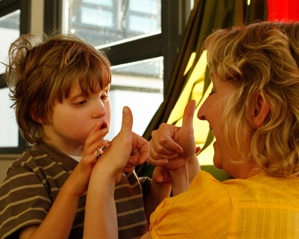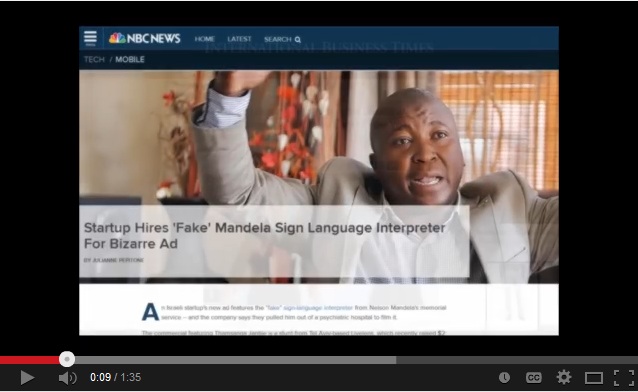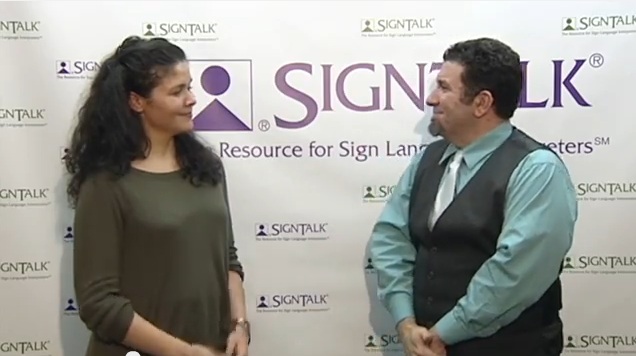Ethics: May I be Included in a Group Photo with my Students?
Dear Ethicist:
The Deaf students in my high school went on an end of the year field trip and I joined them as the interpreter. The students wanted a group picture in front of the museum that included me. Can I be in a group picture with the kids, on the kids’ phones? I don’t know how they will use the picture. (I also want a picture with the kids and me because I’ve been working with them all year and I’m fond of them.) What should I do?
Signed,
I Promise Not to Instagram the Picture
How Do We Participate when Tradition Expects Us to Hear?
 Jewish holidays mark moments in time in the story of a people. The traditions bind the past to the present — reminders of historical events as well as guides for present and future generations.
Jewish holidays mark moments in time in the story of a people. The traditions bind the past to the present — reminders of historical events as well as guides for present and future generations.
Sharing this information from generation to generation is an integral part of every holiday. For my parents, the weekly observance of Shabbat created an opportunity to sit down to a family dinner with their nine children – a weekly experience marked by lighting of the candles, saying the blessings over the wine and challah, and sharing a family dinner. Continue reading
Educational Interpreting for a Neurodiverse Child
Last year, I worked as an interpreter for a young student with CHARGE Syndrome. While the student was in a program for children with special needs, she was the only student in the school with CHARGE. CHARGE can cause deafness and blindness, as well as physical and cognitive complications. In Alex’s case (whose name has been changed), she has cognitive delays (congruent with learners who are deaf-blind), has blurred vision in part of her visual field, balance issues, low musculature, pain from constipation, some repetitive behavioral tendencies, and self-stimulating physicality—similar to those observed in children with autism. These behaviors may include clapping, tooth grinding, and tense jumping. This job was not what interpreters are trained as in terms of “typical interpreting.” As such, the work constantly generated questions and challenges for me about my role and daily practice. Like many educational interpreting jobs, issues arose about the meaning of true inclusion, as these issues were all the more heightened by physical disability and neurodiversity. Continue reading
Inhale, Exhale, Sign: Accommodating Yoga for the Deaf and Hard of Hearing
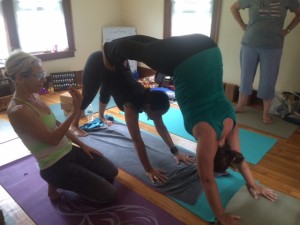
Photo by Jennifer Wilkinson http://www.consciouscontactli.com/about.html
I wholeheartedly encourage everyone in the world to try yoga – I practice regularly up to five or six times a week. It has changed my life — helped me be a better mother, gotten me through rough patches in my life, brought me better health, more energy, and a sense of inner well- being.
A few months ago, I suggested to a deaf friend that she come to yoga with me. She immediately responded, “Well, I would love to… but I can’t. I’m deaf. How will I follow the class?” I said, “What do you mean, you CAN’T? Of course you CAN. Just show up to class. I’ll be there by your side, and I guarantee you will feel comfortable.”
Thankfully, she agreed.
In the News: SignTalk Foundation / CODAs of Color featured on NY 1 Today
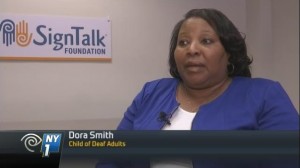 Featured today on Time Warner/NY1 — CODAs of Color, a workshop sponsored by SignTalk Foundation and developed and led by Celeste Owens, NAD V, NIC, provides children of Deaf adults with an introduction and access to the field of sign language interpreting. To see the 2-minute news clip, go to https://www.youtube.com/watch?v=eQLw_NU8Ml0&feature=youtu.be.
Featured today on Time Warner/NY1 — CODAs of Color, a workshop sponsored by SignTalk Foundation and developed and led by Celeste Owens, NAD V, NIC, provides children of Deaf adults with an introduction and access to the field of sign language interpreting. To see the 2-minute news clip, go to https://www.youtube.com/watch?v=eQLw_NU8Ml0&feature=youtu.be.
SignTalk Foundation is Pleased to Sponsor ‘CODAs of Color,’ an Innovative Workshop Series
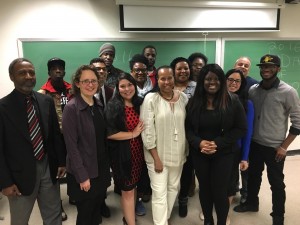 Many of us see a need and wonder how to do more — to affect something or someone in a positive way. The SignTalk Foundation recently sponsored a six-week program, “A Basic Introduction to Professional Sign Language Interpreting,” for adult and young adult CODAs of Color, led by Nationally Certified Interpreter, Celeste Owens, NAD V, NIC.
Many of us see a need and wonder how to do more — to affect something or someone in a positive way. The SignTalk Foundation recently sponsored a six-week program, “A Basic Introduction to Professional Sign Language Interpreting,” for adult and young adult CODAs of Color, led by Nationally Certified Interpreter, Celeste Owens, NAD V, NIC.
The purpose and goal of this program was to introduce, share and enlighten CODAs of Color to the field of professional sign language interpreting. The sessions covered skills required in a variety of interpreting environments, the Code of Professional Conduct and its application in various settings, panel discussions with certified/qualified interpreters who shared their background and experiences, and a session in which members of the SignTalk staff discussed opportunities available to professional interpreters.
As a professional interpreter and CODA of Color herself, Celeste has been a long-time advocate and supporter of the Deaf Community in NYC — particularly the Black-Deaf community. SignTalk is extremely pleased to have partnered with Celeste and provide a grant in support of this six-week workshop series. The feedback from the students has been overwhelmingly positive and we wish them success in the future.
To see the 2-minute news clip featured on Time Warner/NY1 — CODAs of Color, go to https://www.youtube.com/watch?v=eQLw_NU8Ml0&feature=youtu.be.
Captioning is a win for everyone
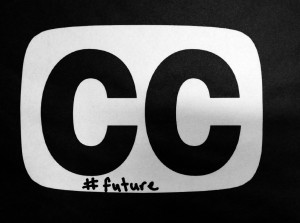 Captioned content is mushrooming! YouTube and Google have long recognized the value of captioning, not only to reach the Deaf and hard of hearing, but for general hearing audiences in different countries, as well as non-English speakers in the US. They have developed an easy to use captioning technology for YouTube posters to add captioning capabilities to their content. As YouTube’s technology can translate into ten languages, its focus is to bridge the gap between languages rather than on the Deaf and hard of hearing community—still, it’s a win for us! YouTube has enabled automatic captioning for 135 million videos, more than tripling the number of captioned videos since 2011.
Captioned content is mushrooming! YouTube and Google have long recognized the value of captioning, not only to reach the Deaf and hard of hearing, but for general hearing audiences in different countries, as well as non-English speakers in the US. They have developed an easy to use captioning technology for YouTube posters to add captioning capabilities to their content. As YouTube’s technology can translate into ten languages, its focus is to bridge the gap between languages rather than on the Deaf and hard of hearing community—still, it’s a win for us! YouTube has enabled automatic captioning for 135 million videos, more than tripling the number of captioned videos since 2011.
In 1993, Congress ruled that captioning capabilities must be installed on all analog TVs with screens large than 13 inches. Since then, the law has
been updated to include digital TVs, as well as tablets and phones with much smaller screens. And yet, when a Deaf education teacher wanted to show a PBS movie “Homefront and Warfront: World War II” to her class, she discovered that the movie was not captioned. When she wrote to PBS to inquire as to why they failed to make a historical feature accessible to Deaf and hard of hearing students, PBS responded that this particular content fell outside the timeframe required by the FCC.
The National Association of the Deaf, the country’s leading organization that monitors captions, has sued both Netflix and Amazon because popular content, including the 50th anniversary showing of “The Wizard of Oz” had not been captioned. The courts ruled in favor of Netflix saying that Netflix doesn’t actually have to comply with ADA laws because it isn’t connected to a physical space. Even though they won the suit, Netflix has plans to caption everything, and Amazon currently captions all its Prime content and intends to caption 100% of its digital content. Again, though their focus is not specifically to accommodate the Deaf and hard of hearing communities, but rather to make viewing of Netflix and Amazon stations available in bars and restaurants, this too is a win for us.
Anyone who has watched automatically captioned YouTube videos can give you examples of captioning gone awry, but we trust that, as technology tends to do, this will improve with time. Currently the FCC requires video clips aired on TV to be captioned with 30 days. As of July 2017, captioning will be required within 12 hours. As for “Homefront and Warfront: World War II” as of this writing, it has still not been captioned.
We Need Recreational Signers
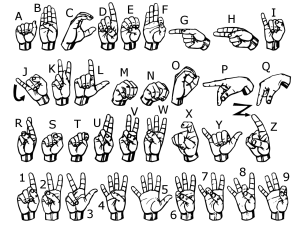 Upon first encountering people communicating in sign language, many hearing people may exclaim enthusiastically, “Oh, ASL is such a beautiful language!” Basically, asking “Can I join?” Interpreters may roll their eyes – after all, speaking in ASL is our profession.
Upon first encountering people communicating in sign language, many hearing people may exclaim enthusiastically, “Oh, ASL is such a beautiful language!” Basically, asking “Can I join?” Interpreters may roll their eyes – after all, speaking in ASL is our profession.
But welcoming potential signers will go a long way in opening up communication between Deaf people and the rest of the hearing population. This is a good thing.
- Interpreters don’t have a monopoly on communication. We aren’t going to lose our jobs if teachers, lawyers, nurses, mechanics, and baristas decide to take an ASL class. Not everyone wants to be an interpreter even if they do want to become youTube stars by interpreting Bruno Mars songs.
- Hearing signers open up communication. We’ve all seen Rebecca King order her frappuccino from Katie Wyble via the Evolution Screen at the St. Augustine, FL Starbucks. What made that interaction possible, along with technology, was hearing signers, not interpreters. Ms. Wyble is one of a handful of signers at that Starbucks. Ms. Wyble was smitten the first time she saw ASL, so she studied it for 4 years. Her studies helped her do her job well and made Ms. King’s day. St. Augustine has a huge signing community as the Florida School for the Deaf and Blind is located there. The large signing community makes it easy for Starbucks to hire signing baristas.
- Native ASL users live among us. ASL differs from other foreign languages in that many non-English speakers may understand sufficient English with which to communicate and may improve their English skills with time. (I took 2 years of high school Russian and have never said more than da or niet to any native user.) But often ASL is the only language accessible to native users. Therefore, ASL students may have the opportunity to interact with Deaf people in their own neighborhood.
- ASL feels accessible to hearing Americans. Unlike other foreign languages, ASL doesn’t threaten English speaking Americans, either because we code it in English or because it’s a manual language. Whatever the case, Americans are willing to take ASL and practice it almost immediately, by approaching complete strangers and awkwardly signing, “H-I. My name is A-M-B-E-R.”
- Signing students have exposure to Deaf culture. Hearing people who become ASL signers will naturally learn much about Deaf culture and to appreciate the Deaf accent. As more people include Deaf people among their community of friends and acquaintances, there will be more acceptance and fewer acts of discrimination, like this one.
So, the next time an eager, potential signer tells you ASL is beautiful, invite them in. A warm response–It is a beautiful language! Learn it!–will go a long way in creating an abundance of recreational signers.
Starbucks and the Evolution Screen
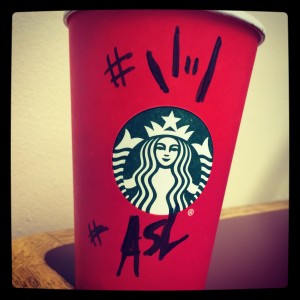 While much of America is obsessing over the meaning (or lack thereof) of Starbucks’ red cup, some of us are focused on Starbucks for a more unifying reason — the great communication leap forward.
While much of America is obsessing over the meaning (or lack thereof) of Starbucks’ red cup, some of us are focused on Starbucks for a more unifying reason — the great communication leap forward.
Rebecca King, a Deaf Starbucks patron, pulled up to her local St. Augustine, Florida Starbucks’ drive-thru window expecting the usual struggles communicating through a kiosk. She was shocked–and ecstatic–when a signing employee appeared on an Evolution Screen.
This is the first known Starbucks to install an Evolution Screen, in which an interpreter communicates with the driver on the screen if they haven’t responded within a certain amount of time.
Be one of the 6 million plus people to view Ms. King easily ordering her Frappuccino in sign language.
The St. Augustine Starbucks employs a handful of signers as the town hosts a large Deaf and signing community, as well as the Florida School for the Deaf and Blind. ASL is offered at many of the local high schools and colleges.
Not all Starbucks are as accommodating as St. Augustine’s. In 2013, two New York City Starbucks made Deaf News Today and The New York Times by refusing to serve Deaf customers, making fun of the Deaf accent, and even calling the police to remove Deaf patrons. The Deaf patrons sued Starbucks. Starbucks responded quickly in print and video reiterating that all customers, including Deaf customers, should feel welcome and enjoy the Starbucks Experience.
Indeed, what happened in New York City seems to be an anomaly. Starbucks has a history of hiring Deaf employees in many of their stores, from South Korea to Santa Monica, CA. Starbucks is an active participant in RIT’s Coop Program, which offers internships to Deaf college students and hires many of them. According to this video, there are 5 Deaf employees at the Starbucks headquarters in Seattle, WA and Starbucks actively meets all of their communication needs.
Of course, an Evolution Screen isn’t practical for all fast food restaurants, nor do all restaurants have easy access to signing employees. To help facilitate communication, Starbucks also stocks picture cards so any customer can point to the drink of their choice and size without a struggle.
We hope other restaurants and coffee shops will follow suit and install drive-thru touch screens, making it easier for everyone to place accurate orders.
Great job, Starbucks. I raise my red cup to you.

